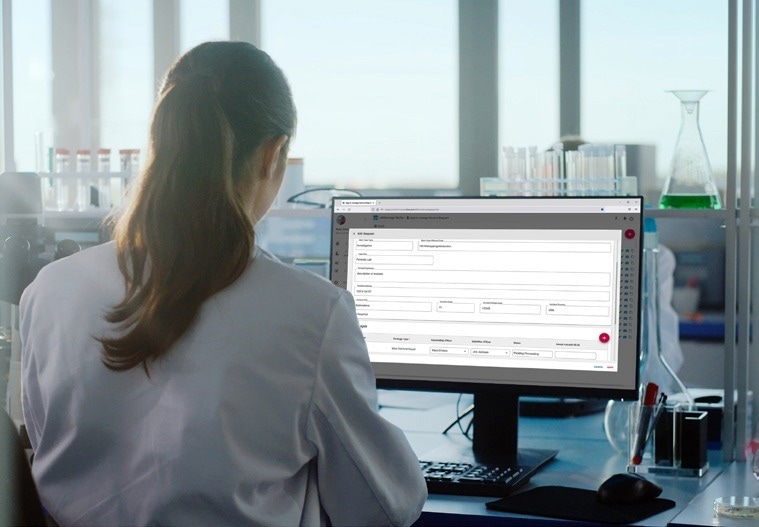Being able to solve crimes means that people are increasingly reliant on a diverse range of scientific disciplines, including nearly every branch of the physical, biological, and computer sciences.

Image Credit: LabVantage Solutions
Crime lab personnel and other justice system contributors depend heavily on automated laboratory information management systems (LIMS) to handle the monitoring of case samples and associated data throughout their life cycle and before, during, and after the testing methods.
This is true regardless of the work involved, such as recognizing a complex designer drug used in a date-rape case, amplifying DNA gathered at a scene of a crime, or looking for evidence in a computer hard drive.
The scientific work involved in solving crimes is not limited to the lab; it starts at the scene of the crime and continues through the course of the investigation to the courtroom and beyond. Since DNA evidence has become a major factor in determining guilt or innocence, the scientific chain of evidentiary custody in cold cases can now last for decades.
To answer the special needs of the forensics lab and all the many justice system players who rely on the lab, an expanded LIMS known as forensic information management systems (FIMS) has been developed.
Everyone involved can benefit from using a FIMS, such as LabVantage Forensic NavigatorTM, to maintain an unquestionable electronic chain of custody of evidence, regardless of the type of crime that has been committed or how the investigation develops from the moment police arrive on the scene until the day of either conviction or exoneration of the suspect(s).
Turning challenges inside out
Even the smallest crime lab will be staffed with technicians who receive evidence and handle property, forensic examiners, and quality assurance personnel. Everyone in these positions will be a frequent, intensive user of the FIMS, consistently completing a variety of duties. As frequent users, they also need a solid awareness of what the FIMS can do.
However, as was mentioned, the work done in the lab only makes up a small piece of the forensic picture. Others also require access, but typically only to a small selection of features and datasets. For instance, crime scene professionals will not necessarily need to use the complete FIMS, but they will, at the very least, need to log evidence, conduct on-site examinations, and start the chain of custody.
The status of a case or an examiner report may only sometimes need to be viewed by law enforcement personnel or attorneys. A statistical performance report may only need to be reviewed by managers once a month.

Image Credit: LabVantage Solutions, Inc.
These folks, along with others, simply need to use a portion of the system’s unique features. They do not require access to information outside of their scope or to carry out tasks outside of their job description. Additionally, corporations do not want to give users outside of their lab system-wide access for security concerns.
Without secure, easy access to the FIMS, the overall operation does not take full advantage of what the system offers. The solution is a portal into the FIMS that can be made briefly and specifically accessible to outside resources.
The ability for an extended network of professionals to contribute data and make requests in real-time, as well as automate and streamline operations without compromising on security or adherence, offers a highly efficient, secure, and economical solution.
Without such access to the site, forensic stakeholders may have serious operational inefficiencies, such as:
- Delays: Every time an external resource requests information, work processes in the lab are interrupted, and clients may become iratated when calls, emails, and other inquiries are not answered right away.
- Data integrity and accessibility: Data entry errors will undoubtedly occur when humans are manually entering information that they first received from another person(s), and without shared access, real-time information is unavailable during the request life cycle.
- this section doesnt make sense to me. im not sure how to fix it. Security: Organizations run the danger of having evidence or processing methods detected in an audit or, worse yet, used as evidence in a trial if access to the entire system is not restricted. Additionally, it may open up access points for cybercriminals.
The right tools, combined
The phrase “portal” has grown so commonplace that it is often misunderstood, even though portals can be quite sophisticated.
A portal is a secure subset of system data that can be made accessible to outside parties who have very precise and constrained access needs. In comparison to the comprehensive system itself, it offers a highly effective window into the user's system and makes interaction much easier.
Users of the portal authenticate through a proxy server and firewall rather than logging in using the same method as FIMS users in a portion of the system’s data. They are essentially accessing the same database’s data as internal, full-access users, but with many restrictions on what they can view and do.
LabVantage’s safe web portal safeguards confidential information while removing the need for manual orders for tests and other services. It also supports our well-liked LIMS, the most cutting-edge and adaptable LIMS on the market.
Portal features are now more user-friendly than ever for people outside the lab who require data access but are unfamiliar with LIMS technology, thanks to a redesigned, next-generation user interface.
The LabVantage portal, which works on PCs, tablets, and phones, was created using an approach to apps that enables users to configure the view to their needs without writing any code. It features all the tools and functionalities in one place that are needed to allow users to finish their forensic work.
Apps can be utilized for a variety of tasks, such as account management, evidence submission requests, retrieving examiner reports, and any other features that users design as individually configured apps.
Beyond evidence pre-log, the portal can be utilized for several things. The portal, for instance, is the ideal location for a law enforcement official to seek services for the evidence items and afterward view the lab’s answer to the service request.
Observing the lab’s response to service requests can cut down on the time that is wasted when transporting unnecessary evidence and may even lead to fewer chain-of-custody transactions for the evidence. An officer can track the evidence’s progress through the examination process using the portal.
The officer or prosecutor will also access the released official examiner reports here. The site might also be used to inform the staff members that are in charge of property management about disposal choices and to share information regarding investigative leads such as CODIS/NIBIN/AFIS hits.
The tracking of sexual assault kits from the hospital or sexual assault treatment facility through testing, with updates sent to survivors, is another crucial application of the portal’s capability.
Queries no longer cause delays because external resources may log in fast and obtain the data they require without bothering lab employees. Additionally, when an external resource logs into the portal, they see information as it is right now rather than an outdated piece of information that might have changed while waiting for a lab employee to answer the initial request.
As a result, internal FIMS users are no longer involved in the process that enables other forensic stakeholders to submit requests and obtain information because external customers are now self-sufficient.
The LabVantage advantage: A secure, intuitive portal experience

Image Credit: LabVantage Solutions.
The LabVantage portal is a full, internal component that, when used in conjunction with LabVantage Forensic Navigator, enables criminal investigation labs to offer restricted and indirect access without sacrificing safety or compliance, allowing non-lab personnel to easily enter sample login information, carry out status checks, and view finished analysis reports.
Thanks to LabVantage’s proactive approach to cybersecurity, data security is maintained as the top priority throughout the process.
The most recent iterations of the flagship LIMS were created expressly with an emphasis on cybersecurity, taking both user feedback and research into consideration.
The configurable security protocols and permissions of the device meet the highest regulatory requirements, and the data is encrypted in multiple stages, including all data within cloud servers and in the VPN tunnels associated with the subscription-based SaaS version of Forensic Navigator.
Additionally, LabVantage has taken a very proactive approach to security by doing penetration tests and other activities that enable consumers to keep ahead of any potential intrusions.
LabVantage combines SonarQube and Atlassian’s Jira to review and scan source code for potential vulnerabilities, enabling everybody to closely monitor code and raise awareness of any security risks during development.

Image Credit: LabVantage Solutions
To prevent harmful files from being uploaded, designers can also use “magic byte” detection, which is a list of file signatures and data used to identify or validate file contents. The company also carefully monitors any third-party activities. In addition to aiming for the highest level of data protection, LabVantage works to give portal users the best possible Forensic Navigator interface experience.
The user-friendly, appealing dashboard is straightforward and intuitive, and it requires little to no training. It is browser-independent and functions on all platforms, including PCs, tablets, and smartphones. The self-support strategy for lab administrators makes use of their current LabVantage functional expertise, configuration tools, and other aptitudes.
Better results, faster
The LabVantage interface was created with maximum configuration flexibility in mind and enables requests for services, ordering of kits, retrieval of findings and reports, tracking of shipments, and more. Users can modify the functionality of a portal to suit their specific requirements using apps without writing code.
Dashboards, webpages, queries, reports, and other tools and features that a user needs to perform their task are all gathered in one location by LabVantage’s portal apps.
Based on what is needed, forensic stakeholders may use multiple apps to fulfill their tasks.
Users can set up their unique app, or several apps could be styled to offer portal account administration, submission requests, and kit requests.
The combination of Forensic Navigator with the LabVantage portal, regardless of what a forensic investigation requires, can produce results more quickly while ensuring an optimal access and retrieval process through direct access in a highly secure environment.
About LabVantage Solutions
LabVantage Solutions, Inc. is the leading global laboratory informatics provider. Our industry-leading LIMS platform, including ELN, LES, and SDMS, and world-class services are the result of nearly 40 years of experience in laboratory informatics. LabVantage offers a comprehensive portfolio of products and services that enable companies to innovate faster in the R&D cycle, improve manufactured product quality, achieve accurate recordkeeping and data integrity, and comply with regulatory requirements.
LabVantage is a highly configurable, web-based LIMS platform that powers hundreds of laboratories globally, large and small. Built on a platform that is widely recognized as the best in the industry, LabVantage can support hundreds of concurrent users as well as interface with instruments and other enterprise systems. It is the best choice for industries ranging from pharmaceuticals and consumer goods to molecular diagnostics and bio banking. LabVantage domain experts advise customers on best practices and maximize their ROIs by optimizing LIMS implementation with a rapid and successful deployment.
Sponsored Content Policy: News-Medical.net publishes articles and related content that may be derived from sources where we have existing commercial relationships, provided such content adds value to the core editorial ethos of News-Medical.Net which is to educate and inform site visitors interested in medical research, science, medical devices and treatments.